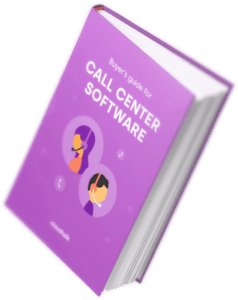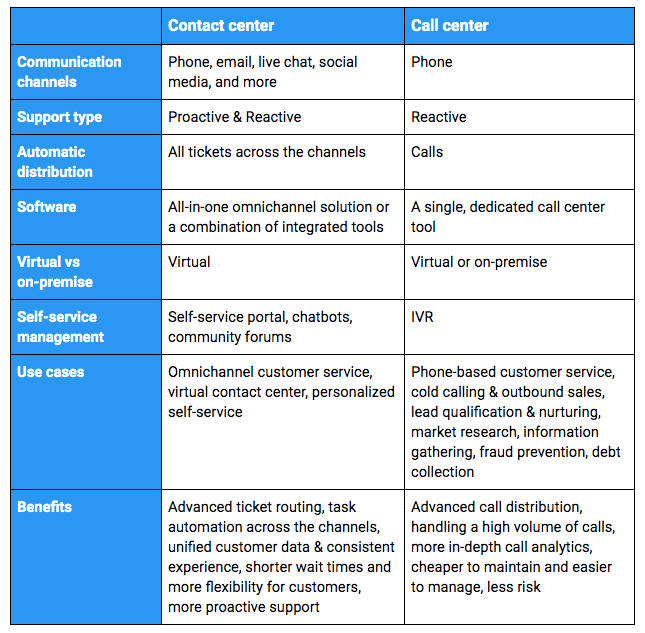Contact center vs call center: The ultimate comparison

The terms ‘contact center’ and ‘call center’ are often used interchangeably – but the truth is, these terms don’t actually mean the same. There are some differences between them, which we’re about to cover in this blog post. Here’s your ultimate comparison of call center vs contact center.
It might seem otherwise, but contact centers and call centers serve different purposes and deliver quite different customer experiences. They do have certain similarities but are not exactly the same at their core.
What are the differences between a call center and a contact center, then? Let’s start with the basics.
Contact center vs call center: What is a contact center?
Essentially, contact centers provide the means for omnichannel support. They revolve around several channels – live chat, email, phone calls, or text messages, just to name a few. Such centers are usually seen as a core of a business, especially when its customers are demanding and active across various digital channels.
Learn how to choose the best call center software in our buyer’s guide

Contact center – use cases
- Omnichannel customer service – modern contact centers offer an “integrated” experience & support across many communication channels
- Virtual contact center – with powerful contact center tools, agents can work from any location and handle multiple communication channels
- Personalized self-service – with comprehensive contact centers, customers can perform routine tasks (i.e. checking account balance or scheduling an appointment) without the need to interact with contact center agents
In order to create your own contact center and offer a seamless service across the channels, though, you should rather choose a single omnichannel support solution (this way, contact center pricing is better since you don’t need to pay for more than one tool) or pick a few dedicated tools that can be integrated with one another.
In both cases, you will be able to keep all the important details in one place and serve your customers in a fast & efficient manner.
Contact center – benefits
1. Advanced ticket routing.
Contact center tools often leverage automation when it comes to ticket creation, updates, assignment, and time-based triggers. These ticketing tools have to take into account all available information on every customer who is reaching out, and “route” them to the agent that can assist them best, based on this information.
This way, contact centers are able to reduce the resolution time and increase customer satisfaction.
2. Task automation.
Speaking of using automation – such tools also have specific features that are designed exclusively to improve agent productivity. With so many channels to manage, agents tend to have a lot on their plate.
Canned responses or forms, for example, reduce repetitive tasks and give agents more time to engage with customers.
3. Unified customer data & consistent experience.
When your business is present and reachable across the channels, it’s bound to gather a lot of customer data. Omnichannel support platforms or software that’s connected through integrations can easily give you a 360-degree view of all customers, and serve them better in the long run.
Such tools also allow for making the whole customer experience more consistent, which gives customers more freedom to choose communication channels as they please and still be offered consistent support.
4. Shorter wait times and more flexibility for customers.
Since customers have various communication channels at their disposal, their queries are more distributed among different channels & agents, and thus, wait times can get shorter than with a single point of contact.
Basically, customers can choose how they want to reach out each and every time, which can be a great advantage to have.
5. Proactive support.
Traditionally, customers were the ones who reached out to companies whenever they needed assistance. These days, however, businesses are able to predict some of the issues that customers might run into, proactively offer solutions before the problem escalates, and provide assistance across the channels.
For example, live chat software makes it possible to reach out to customers while they’re browsing your website and start the conversation to encourage them to convert.
Call center vs contact center: What is a call center?
Call centers revolve around one main communication channel: phone. They can handle inbound or outbound calls and both. In fact, they are designed to handle a large volume of calls of all sorts, depending on the specificity of the business and customer needs.
As a result, call centers are used for a variety of purposes: customer support, telemarketing, or any other sales-related calls, just to name a few. With modern call center software, the choice is entirely up to you.
What purpose can call centers serve?
- Phone-based customer service
- Cold calling & outbound sales
- Lead qualification & nurturing
- Market research
- Information gathering
- Fraud prevention
- Debt collection
On-premise & cloud-based call centers
It’s also worth keeping in mind that there are two main types of call centers: on-premise and cloud-based. As the name suggests, everything in an on-premise call center is located on your premises.
Be it the software, hardware, servers, staff, or anything you can possibly think of. This means that setup and maintenance are entirely your responsibility, and you have to cover all the costs yourself.
When it comes to cloud-based solutions, though, everything is hosted in the cloud and provided by a third party. Therefore, call centers only need a proper device, headphones, and Internet connection to make and receive calls.
The actual software is set up, maintained, and upgraded by the call center software provider, which also offers additional support during the whole process.
Call center – benefits
1. Advanced call distribution.
Call center software is fully capable of distributing calls in the most efficient manner possible, in order to increase customer satisfaction and agent productivity. Interactive Voice Response (IVR) can serve as a good example here – callers can feel like they’ve been faster attended to, and expect assistance tailored to their needs once they get connected with the most suitable agent.
2. Handling a high volume of calls.
The sole focus of call centers is on the phone channel, which is why modern call center tools are designed to handle a high volume of phone conversations. What’s more, it’s extremely easy to set up a virtual call center and start making & receiving calls.
3. More in-depth call analytics.
Any customer data is collected via telephone, which makes it easier to access available information and assist all callers properly. Not to mention that most call center solutions provide access to in-depth analytics due to their specialization. This way, you can easily get detailed information about your calls, including the real-time performance of agents and calling trends.
4. Maintaining a call center is less expensive.
Call centers tend to be cheaper than omnichannel centers. Especially in the case of virtual ones – you only need to take care of a few things first in order to launch your own call center. Then, your agents have to be skilled only in providing phone support, rather than managing all customer queries across the channels. The scope of call center tools and functions is also different, and so are their costs.
5. There’s less risk.
If your agents have only one channel to focus on and manage, it’s much easier to do it properly. The more communication channels available to customers, the harder it gets to keep an eye on them and give every customer query the attention it deserves. Plus, the communication among agents also gets easier – the customer-facing team is not segmented and works towards a common goal. All important information (contacts, customer history, or performance data) is kept in one place and shared across the whole team.
6. It’s easier to manage agents and their tasks efficiently.
When you think about it, call center managers can distribute the tasks easily between the agents for maximum efficiency in real-time. A single communication channel paired with shared contacts and objectives make it much easier to manage the whole team and act fast whenever needed.
Contact center vs call center: What’s the difference?
As can be seen, both call & contact centers leverage phone communication to some extent and are used for various purposes. The similarities pretty much end there, though.

Does your business need a call center or a contact center, then?
Both contact & call centers can become an essential element of your business. However, since they are not exactly the same, you should pick which one can help you serve your customers better. Here’s how:
- If your customers prefer calling you – it’s high time to create a well-functioning call center. In such cases, there’s no need for you to invest in other channels. Powerful call center software like CloudTalk can easily provide you with everything your agents and callers need, including IVR, advanced call routing, post-call automation, or comprehensive analytics.
- If your customers expect you to be present across the channels – you might want to meet these expectations and set up a robust contact center instead. Omnichannel support can work wonders for your business and your customers, especially if you already have a large company and a lot of versatile agents on board.
- The choice truly depends on the needs of your customers and the specificity of your business. It’s important to realize, however, that both contact centers and call centers can bring you multiple benefits, including the ability to offer outstanding support.
The difference between a call center and a contact center explained
As you can see, the main similarity of call centers and contact centers is in the name. That’s precisely why it’s difficult to say which one is better – they can serve different purposes and needs.
Essentially, a call center allows you to engage with your customers via phone, while a contact center helps you leverage a variety of channels. In the end, you should take into account which of these channels are preferred by your customers.
No matter the choice you’ll make, you’re going to need powerful software to help you run your operations. In case you’re looking for a complex call center solution – see what CloudTalk has to offer.
Download a step-by-step buyer’s guide on how to choose the best call center softeware
















